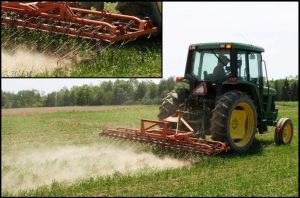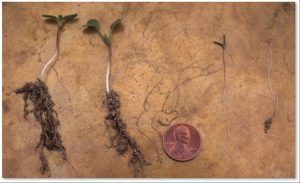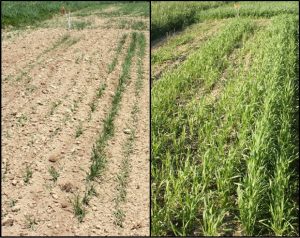Maine Grain and Oilseed Newsletter, Vol. 2, No. 2 – June 2014
In this issue:
- Tine Harrowing or Rotary Hoeing for Weed Control in Small Grains
- NRCS Announces Application Deadline for Conservation Programs
Dear Grower,
For many areas, crops seem to be doing well despite the late plantings, and weather conditions post-planting have been more favorable than what was experienced last year. In this latest issue of the newsletter you will find an article on tine harrowing for weed control in small grains. As well, we have included an announcement from USDA-NRCS for funding and application deadlines for EQIP and AMA conservation programs.
Sincerely,
Andrew Plant, Extension Agriculture Educator
Ellen Mallory, Sustainable Agriculture Specialist
57 Houlton Road, Presque Isle, ME 04769
207.764.3361 or 1.800.287.1462
extension.umaine.edu/aroostook
Tine Harrowing or Rotary Hoeing for Weed Control in Small Grains
Ellen Mallory, Sustainable Agriculture Specialist, and Eric Gallandt, Associate Professor or Weed Ecology, University of Maine
Effective weed management in small grains has to start with a competitive crop. For instance, seeding into low, wet, heavy soils is generally a bigger problem for small grains than weeds. Timely seeding and adequate to high seeding rates are important especially if weeds are expected to be a problem. Other practices that can contribute to a multiple-tactic weed management plan include a diverse crop rotation, suitable varieties and high quality seed, undersowing with clover, and avoiding fields with heavy weed pressure. Mechanical weed control in small grains is generally limited to tine harrows or the rotary hoe. For organic growers, once the crop is planted, these so-called “blind” cultivation practices are the only mechanical options for removing weeds from a small grain crop on typical 6- to 7-inch row spacing. Employed properly and under optimal conditions (see below), blind cultivation can be very effective, killing 80 to 90% of weeds.
What it is and how it works
Blind cultivation takes advantage of differences in size and rooting depths of the crop and weeds. A rear-mounted flexible tine harrow or rotary hoe is dragged across the field at relatively high speeds (3 to 6 mph) without regard for the location of rows. The action of the implement dislodges and/or buries very small, shallow-rooted weeds, and uprooted plants then die from desiccation. Flex-tine or spring-tine harrows are the most commonly used implements. As they move across the field, the flexible tines wiggle back and forth and uproot shallow-rooted plants while moving around well-rooted plants and other obstacles (Photo 1). The aggressiveness of a tine-weeder can be adjusted by changing the angle of the tines, down pressure, and tractor speed. Generally, with increasing weed size, harrowing has to be increasingly aggressive to provide a similar degree of control. However, with more aggressive harrowing there is also more direct crop damage and burial.
Blind cultivation should target weed seedlings in the “white thread stage,” such as common lambsquarters that germinate around the time the crop is planted (Photo 2, right). Blind cultivation is less effective against larger-seeded weeds that germinate from greater depths, like wild mustard (Photo 2, left). It is not at all effective against bigger annual or perennial weeds whose root systems are too extensive.
Optimal conditions for blind cultivation
- The crop has not yet emerged (pre-emergence) OR has at least 3 to 4 leaves and is well-rooted (post-emergence). These are the two windows of opportunity for blind cultivation. The second window ends just before the crop starts jointing. After this point tractor traffic will damage the emerging seed heads.
- The weeds are in the white thread stage or are just emerging. “White thread” refers to the appearance of the root system. Once the weeds develop multiple fine roots they become much harder to uproot from the soil.
- The soil is dry and friable; and the weather is hot and dry.
- A fine, level seedbed has been prepared with no large clods or clumps of grass. Soil clods and ridges can prevent the tines from completely dislodging weed roots and clods may cover exposed roots protecting them from desiccating.
Other considerations
A common piece of advice for farmers using blind cultivation for the first-time is not to worry about the crop but “just go, go, go and don’t look back.” Often farmers will use slightly deeper planting depths to encourage better rooting of the crop, and slightly higher seeding rates to compensate for any crop stand loss that does occur. However, it is important to realize that it is possible to be too aggressive with blind cultivation or to do it too many times. The crop can be damaged by the direct action of the tines and/or soil burial (see Photo 3). Possible yield lost due to post-emergence harrowing should be weighed against the yield gained by the resulting weed control. Start by harrowing a short section, look to see that you’re getting the action you need to uproot and bury weed seedlings but that you are not completely burying sections of your crop, and then make adjustments to the aggressiveness of the tine harrow accordingly. If conditions are less than optimal for blind cultivation, relying on crop competition may be the best course of action.
For more information on blind cultivation and weed management for small grains, see
- Steel in the Field, edited by Greg Bowman. A PDF version of the complete book can be downloaded for free from the SARE website.
- Weed Management, Chapter 6 (PDF), by Jeff Gunsolus, Don Wyse, Kristine Moncada, and Carmen Fernholz, in the Risk Management Guide for Organic Producers. A PDF of each chapter of this book can be downloaded for free at the University of Minnesota Organic Risk Management website.
- Blind Cultivation, by Klaas and Mary-Howell Martens, Lakeview Organic Farm, published on the Rodale Institute website.



NRCS Announces Application Deadline for Conservation Programs
The USDA Natural Resources Conservation Service (NRCS) has announced the application deadline dates for two of its conservation programs — the Environmental Quality Incentives Program and the Agricultural Management Assistance Program. The Fiscal Year 2015 application deadline for both of these programs is August 15, 2014.
Agricultural producers and foresters are encouraged to sign up now for the Environmental Quality Incentives Program (EQIP), which provides financial and technical assistance to address varying natural resource priorities. The Fiscal Year 2015 funding consideration application deadline for most EQIP fund pool categories will be August 15, 2014. This does not include the EQIP National Water Quality Initiative and Conservation Innovation Grants. These deadlines are yet to be determined.
The August 15, 2014 deadline for 2015 funding consideration is for both applications for EQIP local Field Office fund pool categories (such as animal waste, cropland, forestry, seasonal high tunnels, pasture, and wildlife) and the statewide fund pool categories (Beginning Farmer, Socially Disadvantaged, Tribal Projects, Water Conservation/Irrigation, Aquatic Organism Passage Projects, Conservation Activity Plans, On-Farm Energy and Organic). The August 15, 2014 signup deadline is an extension to the previously posted July 1, 2014 deadline for the EQIP local Field Office fund pool, or “general” categories.
Agricultural producers are also encouraged to sign up now for the Agricultural Management Assistance Program (AMA), which also has a Fiscal Year 2015 funding consideration application deadline of August 15, 2014. AMA assists agricultural producers to manage risk and voluntarily address issues such as water management, water quality, and erosion control by incorporating conservation practices into their farming operations. For 2015, Maine NRCS will again be offering financial assistance for irrigation systems and introducing an opportunity for funding deer exclusion fencing for orchards through the AMA program.
There is a continuous, year-round sign-up for these two programs, but applications submitted by August 15, 2014 will be considered for funding in Fiscal Year 2015. Proposals submitted after that date will be held for Fiscal Year 2016 funding consideration.
Interested landowners should visit their local NRCS office located at the USDA Service Center to determine eligibility. USDA Service Centers are listed online, or in the telephone book under United States Government, Agriculture Department.
For more information on EQIP and AMA, please visit Natural Resources Conservation Service Maine.
USDA is an equal opportunity provider and employer.
Information on this website is provided purely for educational purposes. No responsibility is assumed for any problems associated with the use of products or services mentioned. No endorsement of products or companies is intended, nor is criticism of unnamed products or companies implied.
© 2014
Call 800.287.0274 or TDD 800.287.8957 (in Maine), or 207.581.3188, for information on publications and program offerings from University of Maine Cooperative Extension, or visit extension.umaine.edu.
